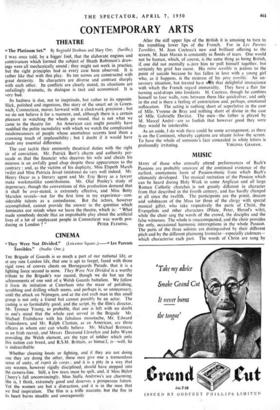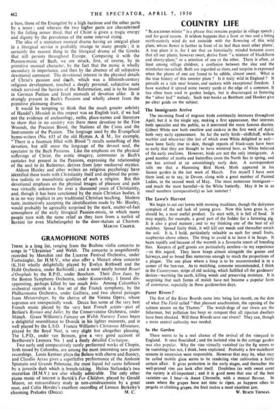MUSIC
MANY of those who annually attend performances of Bach's Passions are probably unaware of the continued existence of the earliest, anonymous form of Passion-music from which Bach's ultimately developed. The musical recitation of the Passion which can be heard during Holy Week in some Anglican and all large Roman Catholic churches is not greatly different in character from that described in the fourth century, and has hardly changed at all since the twelfth. The participants are the priest, deacon and subdeacon of the Mass (or three of the clergy with special musical gifts), who take respectively the parts of Christ, the Evangelists and other characters (Pilate, Peter, Herod's wife), while the choir sing the words of the crowd, the disciples and the false witnesses. The whole is unaccompanied, and the choir provides the only, occasional harmonic interruptions in the whole Passion. The parts of the three soloists are distinguished by their different pitch and by the different plainsong formulae—especially cadences— which characterise each part. The words of Christ are sung by
a bass, those of the Evangelist by a high baritone and the other parts by a tenor ; and whereas the two higher parts are characterised by the falling minor third, that of Christ is given a tragic energy and dignity by the prevalence of the same interval rising. The idea of a miniature musical drama having an integral place in a liturgical service is probably strange to many people ; it is certainly the nearest thing to the liturgical drama of the Greeks that still persists throughout Europe. Comparing it with the Passion-music of Bach, we are struck, first, of course, by its primitive musical character, by the fact that the music is wholly secondary in importance, and then by the absence of all subjective devotional comment. The devotional interest in the physical details of Christ's passion and death, which was a fifteenth-century religious development, touched a deeply personal, subjective note which survived the barriers of the Reformation, and is to be found in German Pietism and Jesuit manuals of devotion alike. It is strongly present in Bach's Passions and wholly absent from the primitive plainsong drama. It would be tempting to think that the much greater sobriety of Handel's Messiah in this respect was an English trait, if we had not the evidence of archaeology, oaths, place-names and literature to show that in no country was there more devotion to the Five Wounds, the Precious Blood, the Stations of the Cross and the Instruments of the Passion. The language used by the Evangelical hymn-writers (No. 633 of the old Hymns A. & M., for example, " There is a fountain filled with Blood ") recalls something of this devotion, but still more the language of the devout soul, the spectator in the Bach Passions. Like the emphasis on the physical sufferings of Christ, the erotic imagery, commoner in Bach's cantatas but present in the Passions, expressing the relationship of the soul to its Redeemer, derives from later mediaeval mystics.
Aldous Huxley and other writers on religious psychology have identified these traits with Christianity itself and deplored the primi- tive sadistic or masochistic qualities of such a religion. But this devotional emphasis on the physical images of pleasure and pain was virtually unknown for over a thousand years of Christianity, and, though it has been sanctioned by the main Christian bodies, it is in no way implicit in any traditional Christian teaching. Modern taste, instinctively accepting the identification made by Mr. Huxley, would probably be agreeably surprised by the stark, matter-of-fact atmosphere of the early liturgical Passion-music, to which many people turn with the same relief as they turn from a surfeit of Bernini (or even Michelangelo) to the door-statues at Chartres.
MARTIN COOPER.







































 Previous page
Previous page